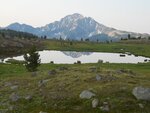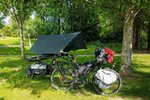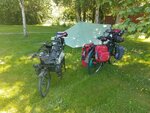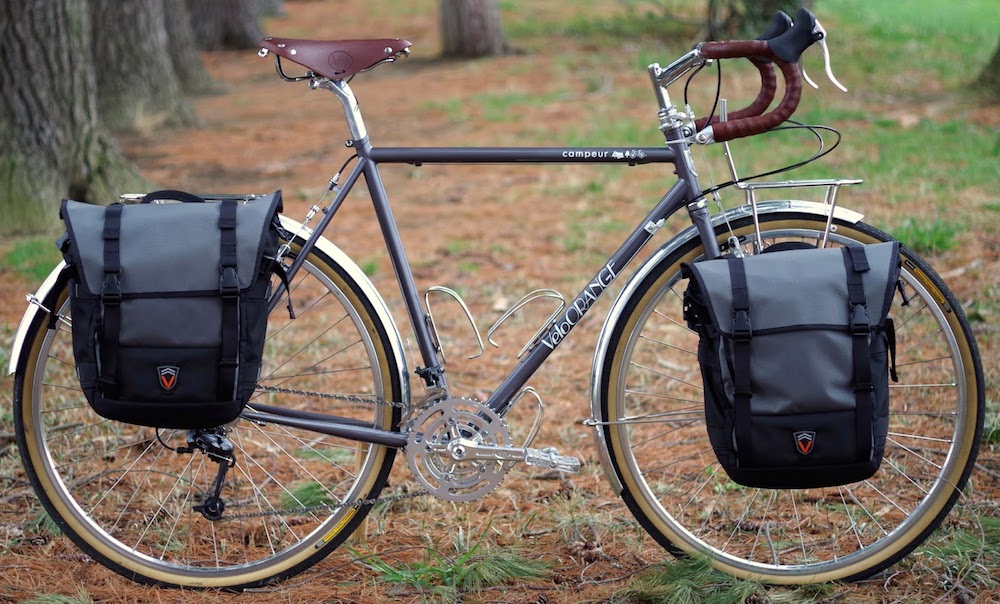Mr. Coffee
Well-Known Member
- Region
- USA
- City
- A Demented Corner of the North Cascades
I was just going to post some thoughts on camping gear.
The big thing is that there is an amazing cornucopia of lightweight camping gear available that is well-suited to bicycle touring. Depending on how much you want to spend and what kind of system you want you can build up a system that might weigh as little as 2kg and provide quite adequate shelter and comfort. In the end as much depends on what you think you need and your camping skillset as it does on what you want to spend.
Tents
There are an amazing assortment of tents available that are well-suited to the bicycle tourist. Some popular examples include:
Bivy Sacks
Bivy Sacks are basically very lightweight miniature tents. The provide minimal stormproofness and bug protection and poor ventilation, but are extremely light and compact. I also find them to be claustrophobic. Also, trying to undress or change clothes in a bivy is almost always more embarrassing than skinning out in semi-public.
Hammocks
There is a whole camping subculture built around hammocks. Hammocks can prove very useful in conditions where there isn't any flat or reasonably dry ground to pitch a tent or tarp. All I can say is that the people who use them tend to like them.
Tarps
Tarp technology has really advanced in the last 20 years! There is a wide assortment of spectacularly light and stormproof tarps available today. In general, a tarp will require quite a bit of skill and judgement and some careful site selection to produce a stormproof pitch, but on the average I've found that you will stay drier in a tarp than in a tent, largely because whatever you lose in weather proofness you gain back in ventilation. Tarps are also effectively variable geometry, so you can vary how you set up the pitch depending on weather conditions (e.g., pitch the tarp low and tight for a storm and high and spacious on a humid rainy night). In addition, you get more protected area per gram with a tarp than with any other shelter.
There are various options for how you arrange yourself within a tarp, from various bug shelters that basically make the tarp a very simple tent to a ground sheet or a splatter-proof bivy sack. No one solution is right and one more advantage of a tarp is that you can change the configuration depending on the type of trip you are on.
It should be noted that with modern materials you are wise to be a little fussy when you set up your shelter. Modern materials like silnylon, spinnaker cloth, and cuben fiber are extremely light and extremely strong, but can fail spectacularly if abused or used improperly. All of these materials handle abrasion poorly, and all of them tend to stretch and sag a bit when wet. Worst of all, if your shelter is sagging or not pitched tightly and you encounter a heavy wind these lightweight materials can rip themselves to pieces in seconds. So it is important to make sure you keep the shelter pitch taut. Ideally you should be able to tighten guy lines (or at least most guy lines) from inside the shelter and preferably without getting out of bed.
The big thing is that there is an amazing cornucopia of lightweight camping gear available that is well-suited to bicycle touring. Depending on how much you want to spend and what kind of system you want you can build up a system that might weigh as little as 2kg and provide quite adequate shelter and comfort. In the end as much depends on what you think you need and your camping skillset as it does on what you want to spend.
Tents
There are an amazing assortment of tents available that are well-suited to the bicycle tourist. Some popular examples include:
- REI Quarter Dome
- Big Agnes Copper Spur HV1
- Tarptent Double Rainbow
- 3F UL Lanshan 1 -- this is a very inexpensive tent that is gaining popularity in the distance hiker world
- ZPACKS Plexamid -- expensive but super light
Bivy Sacks
Bivy Sacks are basically very lightweight miniature tents. The provide minimal stormproofness and bug protection and poor ventilation, but are extremely light and compact. I also find them to be claustrophobic. Also, trying to undress or change clothes in a bivy is almost always more embarrassing than skinning out in semi-public.
Hammocks
There is a whole camping subculture built around hammocks. Hammocks can prove very useful in conditions where there isn't any flat or reasonably dry ground to pitch a tent or tarp. All I can say is that the people who use them tend to like them.
Tarps
Tarp technology has really advanced in the last 20 years! There is a wide assortment of spectacularly light and stormproof tarps available today. In general, a tarp will require quite a bit of skill and judgement and some careful site selection to produce a stormproof pitch, but on the average I've found that you will stay drier in a tarp than in a tent, largely because whatever you lose in weather proofness you gain back in ventilation. Tarps are also effectively variable geometry, so you can vary how you set up the pitch depending on weather conditions (e.g., pitch the tarp low and tight for a storm and high and spacious on a humid rainy night). In addition, you get more protected area per gram with a tarp than with any other shelter.
There are various options for how you arrange yourself within a tarp, from various bug shelters that basically make the tarp a very simple tent to a ground sheet or a splatter-proof bivy sack. No one solution is right and one more advantage of a tarp is that you can change the configuration depending on the type of trip you are on.
It should be noted that with modern materials you are wise to be a little fussy when you set up your shelter. Modern materials like silnylon, spinnaker cloth, and cuben fiber are extremely light and extremely strong, but can fail spectacularly if abused or used improperly. All of these materials handle abrasion poorly, and all of them tend to stretch and sag a bit when wet. Worst of all, if your shelter is sagging or not pitched tightly and you encounter a heavy wind these lightweight materials can rip themselves to pieces in seconds. So it is important to make sure you keep the shelter pitch taut. Ideally you should be able to tighten guy lines (or at least most guy lines) from inside the shelter and preferably without getting out of bed.




